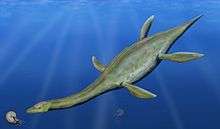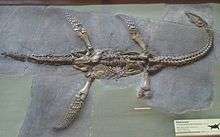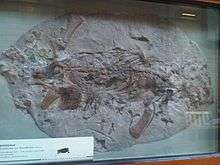Thalassiodracon
| Thalassiodracon Temporal range: Rhaetian - Hettangian | |
|---|---|
 | |
| Thalassiodracon hawkinsi found in the Lower Lias strata, Street, Somerset, England. | |
| Scientific classification | |
| Kingdom: | Animalia |
| Phylum: | Chordata |
| Class: | Sauropsida |
| Superorder: | Sauropterygia |
| Order: | Plesiosauria |
| Suborder: | Pliosauroidea |
| Genus: | Thalassiodracon Storrs & Taylor 1996 |
| Binomial name | |
| Thalassiodracon hawkinsi (Owen, 1838) | |
Thalassiodracon (tha-LAS-ee-o-DRAY-kon) is an extinct genus of small pliosaurs. The type and only species, is Thalassiodracon hawkinsi Owen 1840.[1]
Description

This marine reptile measured 1.5–2 m. (5-6.5 ft) had a relatively long neck but the small skull was proportionally larger than Plesiosaurus, being 1/10 of the total body length.
The neck of Talassiodracon, however, was slightly shorter than that of subsequent Plesiosaurs.The cervical vertebrae were between 27 and 31, while those of Plesiosaurus were 35 - 37. Moreover, the skull was unusually short and equipped with long teeth . The orbits were very large, with sclerotic rings. Like all plesiosaurs, this animal had legs like paddles for swimming in the sea.
A computed tomography of an exceptionally preserved skull, and examination of other specimens (Benson et al., 2011) yields new anatomical data. Thalassiodracon had a dorsomedian ridge on the premaxilla, a squamosal bulb, four premaxillary teeth, and a heterodont maxillary dentition.[2] [3]
Discovery
These animals are known from a number of complete skeletons (Holotype: BMNH 2018) found by the fossil collector Thomas Hawkins in Somerset, England. [1] They lived in the Late Triassic (Rhaetian) to the Early Jurassic (Hettangian) of Europe (age range: 201.6 to 196.5 million years ago).[1]
The genus name Thalassiodracon means "sea dragon", while the species name hawkinsi honours its discoverer.
Classification


Thalassiodracon was originally placed in the genus Plesiosaurus. It has been classified in a new genus Thalassiodracon many years later following an examination of a skull. This animal is considered one of the oldest representatives of the group of plesiosaurs, perhaps ancestral to the superfamily of Pliosauroidea (short-necked plesiosaurs). [4]
The following cladogram follows an analysis by Ketchum & Benson, 2011.[5]
See also
References
- 1 2 3 Paleobiology Database
- ↑ Storrs, G W & Taylor, M A. 1996. Cranial anatomy of a new plesiosaur genus from the lowermost Lias (Rhaetian/Hettangian) of Street, Somerset, England. Jour. Vert. Paleo. 16:403-20.
- ↑ Roger B. J. Benson, Karl T. Bates, Mark R. Johnson & Philip J. Withers Cranial anatomy of Thalassiodracon hawkinsii (Reptilia, Plesiosauria) from the Early Jurassic of Somerset, United Kingdom - Journal of Vertebrate Paleontology - Volume 31, Issue 3, 2011
- ↑ Plesiosauria
- ↑ Hilary F. Ketchum and Roger B. J. Benson (2011). "A new pliosaurid (Sauropterygia, Plesiosauria) from the Oxford Clay Formation (Middle Jurassic, Callovian) of England: evidence for a gracile, longirostrine grade of Early-Middle Jurassic pliosaurids". Special Papers in Palaeontology. 86: 109–129. doi:10.1111/j.1475-4983.2011.01083.x.